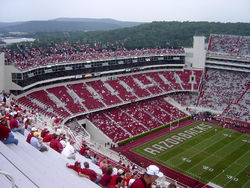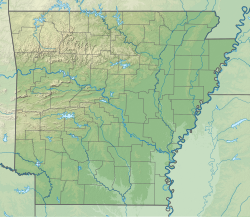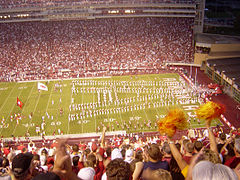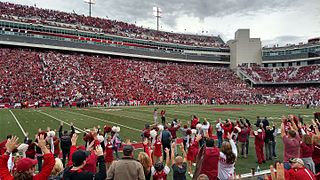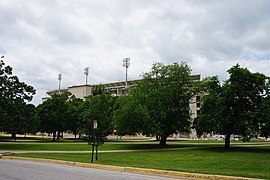
John Franklin Broyles was an American college football player and coach, college athletics administrator, and broadcaster. He served as the head football coach for one season at the University of Missouri in 1957 and at the University of Arkansas from 1958 to 1976, compiling a career coaching record of 149–62–6. Broyles was also the athletic director at Arkansas from 1974 to 2007. His mark of 144–58–5 in 19 seasons at the helm of the Arkansas Razorbacks football gives him the most wins and the most coached games of any head coach in program history. With Arkansas, Broyles won seven Southwest Conference titles and his 1964 team was named a national champion by a number of selectors including the Football Writers Association of America.

Memorial Stadium, nicknamed The Sea of Red, is an American football stadium located on the campus of the University of Nebraska–Lincoln in Lincoln, Nebraska. The stadium primarily serves as the home venue for the Nebraska Cornhuskers.

War Memorial Stadium is a multi-purpose stadium in Little Rock, Arkansas. The stadium is primarily used for American football and is the home stadium for the Catholic High School Rockets, the Parkview Magnet High School Patriots, and the secondary home stadium for the University of Arkansas Razorbacks. The USL League Two affiliated Little Rock Rangers hold both home games and youth academies at the stadium. The Arkansas Activities Association high school football championship games for all classifications are held at the stadium annually.
There are many buildings on the campus of the University of Arkansas. Most of the historic structures are part of the University of Arkansas Campus Historic District on the National Register of Historic Places. This article focuses on the non-listed buildings.

The Arkansas Razorbacks football program represents the University of Arkansas in the sport of American football. The Razorbacks compete in the Football Bowl Subdivision (FBS) of the National Collegiate Athletic Association (NCAA) and the Western Division of the Southeastern Conference (SEC). The program has one national championship awarded by the Football Writers Association of America (FWAA) and Helms Athletic Foundation (HAF) in 1964 and one national championship awarded by the Rothman Foundation for the Analysis of Competitions and Tournaments in 1977. The school does not claim the 1977 title. The program began in 1894 and has compiled an all-time record of 740–539–40, for a .576 winning percentage. The Razorbacks have won 13 conference championships and have had 58 players named honored as All-Americans.
The 1969 Texas vs. Arkansas football game, sometimes referred to as the "Game of the Century", was a college football game played on December 6 in which No. 1 Texas visited No. 2 Arkansas at Razorback Stadium in Fayetteville, Arkansas. The Longhorns came back from a 14–0 deficit after three quarters to win 15–14.
The 1964 Arkansas Razorbacks football team was an American football team that represented the University of Arkansas in the Southwest Conference (SWC) during the 1964 NCAA University Division football season. In their seventh year under head coach Frank Broyles, the Razorbacks compiled an undefeated 11–0 record, won the SWC championship, closed the regular season with five consecutive shutouts, outscored all opponents by a combined total of 231 to 64, and defeated Nebraska 10–7 in the Cotton Bowl.

The Arkansas–Texas A&M football rivalry is an American college football rivalry between the Arkansas Razorbacks and Texas A&M Aggies, which started in 1903. Between 1992 and 2008, the schools did not play each other when Arkansas left the Southwest Conference to join the Southeastern Conference. The rivalry was renewed as a neutral-site out-of-conference contest in 2009; in 2012 it once again became a conference rivalry when Texas A&M also joined the Southeastern Conference. Arkansas leads the series 42–35–3.

The 2012 Arkansas Razorbacks football team represented the University of Arkansas during the 2012 NCAA Division I FBS football season. The Razorbacks played their home games at Donald W. Reynolds Razorback Stadium in Fayetteville and War Memorial Stadium in Little Rock, Arkansas. They were a member of the Western Division of the Southeastern Conference.
The 2004 Arkansas Razorbacks football team represented the University of Arkansas during the 2004 NCAA Division I-A football season. The Razorbacks played five home games at Donald W. Reynolds Razorback Stadium in Fayetteville, Arkansas and two home games at War Memorial Stadium in Little Rock, Arkansas. The Razorbacks were coached by head coach Houston Nutt.

The 2015 Arkansas Razorbacks football team represented the University of Arkansas during the 2015 NCAA Division I FBS football season. The Razorbacks played their home games at Donald W. Reynolds Razorback Stadium in Fayetteville and War Memorial Stadium in Little Rock. They competed as a member of the Western Division of the Southeastern Conference. Arkansas was led by third-year head coach Bret Bielema. Dan Enos served his first season as offensive coordinator, replacing Jim Chaney who left for a job with Pittsburgh. Enos was previously the head coach of Central Michigan.

The 2016 Arkansas Razorbacks football team represented the University of Arkansas in the 2016 NCAA Division I FBS football season. The Razorbacks played their home games at Donald W. Reynolds Razorback Stadium in Fayetteville and War Memorial Stadium in Little Rock. Arkansas played as a member of the Western Division of the Southeastern Conference (SEC). They were led by fourth-year head coach Bret Bielema. They finished the season 7–6, 3–5 in SEC play to finish in a tie for fifth place in the Western Division. They were invited to the Belk Bowl where they lost to Virginia Tech, in a game where the Razorbacks blew a 24-0 lead at halftime.

The 2017 Arkansas Razorbacks football team represented the University of Arkansas in the 2017 NCAA Division I FBS football season. The Razorbacks played their home games at Donald W. Reynolds Razorback Stadium in Fayetteville, Arkansas, with one home game at War Memorial Stadium in Little Rock. Arkansas played as a member of the Western Division of the Southeastern Conference (SEC). The team was captained by quarterback Austin Allen, defensive backs Santos Ramirez and Kevin Richardson II, and offensive lineman Frank Ragnow. The Razorbacks were led by fifth-year head coach Bret Bielema. Bielema was fired after the final game of the season.

The 2018 Arkansas Razorbacks football team represented the University of Arkansas in the 2018 NCAA Division I FBS football season. The Razorbacks played their home games at Donald W. Reynolds Razorback Stadium in Fayetteville, Arkansas, with one home game at War Memorial Stadium in Little Rock. Arkansas played as a member of the Western Division of the Southeastern Conference (SEC). The Razorbacks were led by first-year head coach Chad Morris. They finished the season 2–10, 0–8 in SEC play to finish in last place in the Western Division.

The 2019 Arkansas Razorbacks football team represented the University of Arkansas in the 2019 NCAA Division I FBS football season. The Razorbacks played their home games at Donald W. Reynolds Razorback Stadium in Fayetteville, Arkansas, with one home game at War Memorial Stadium in Little Rock. Arkansas played as a member of the Western Division of the Southeastern Conference (SEC).

The 2020 Arkansas Razorbacks football team represented the University of Arkansas in the 2020 NCAA Division I FBS football season. The Razorbacks played their home games at Donald W. Reynolds Razorback Stadium in Fayetteville, Arkansas. The team competed as a member of the Western Division of the Southeastern Conference (SEC) and was led by first-year head coach Sam Pittman.

The 2021 Arkansas Razorbacks football team represented the University of Arkansas in the 2021 NCAA Division I FBS football season. The Razorbacks played their home games at Donald W. Reynolds Razorback Stadium in Fayetteville, Arkansas. Arkansas competed as a member of the West Division of the Southeastern Conference (SEC) and were led by second-year head coach Sam Pittman.

The 2023 Arkansas Razorbacks football team represented the University of Arkansas in the Western Division of the Southeastern Conference (SEC) during the 2023 NCAA Division I FBS football season. The Razorbacks were led by Sam Pittman in his fourth year as head coach.

The 2024 Arkansas Razorbacks football team will represent the University of Arkansas as a member of the Southeastern Conference (SEC) during the 2024 NCAA Division I FBS football season. The Razorbacks are led by Sam Pittman in his fifth year as head coach. The Arkansas Razorbacks play their home games at Donald W. Reynolds Razorback Stadium located in Fayetteville, Arkansas. They also have one game at War Memorial Stadium in Little Rock, Arkansas.
